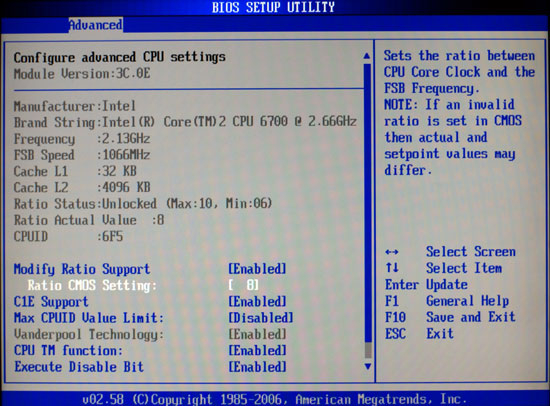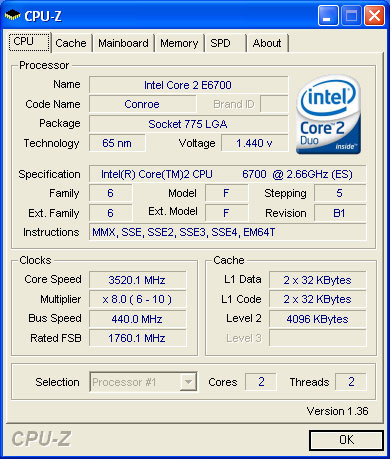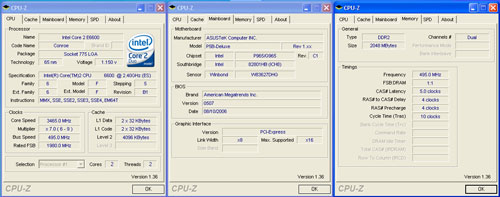ASUS P5B: New BIOS Adds Unlocking & Improved Overclocking
by Wesley Fink on August 24, 2006 3:00 PM EST- Posted in
- Motherboards
E6700
The 0507 BIOS adds a new feature in the BIOS under the "Advanced", "CPU Configuration" tab. Where there was no means to adjust CPU ratios in earlier BIOS versions, with 0507 you now have an adjustment range from 6X to 10X.

Some Conroe chips also unlock at the top, allowing ranges to about 14x. None of our Conroe chips unlocked up, but you may be one of the lucky ones who have a Conroe that unlocks both down and up.
The E6700, which runs at 2.67GHz, is very interesting because of the large headroom we consistently find at stock voltage. Once again, on the P5B Deluxe at stock voltage, the combo could run day and night at 3.4GHz (340x10) with no issues at all. At the stock multiplier of 10x, at 1.4875V the highest stable speed was 360x10 or 3.6GHz, At a reduced 9x the highest speed was 400x9, which is also 3.6GHz. With the new BIOS unlocking multipliers down, we reached 440 at 8x, or 3.52Ghz, as you can see in this screen capture.

7x allowed a further increase to a FSB speed of 494, which is where the 6700/P5B maxed out. Even at a 6X multiplier 494 seems the limit of the FSB with this CPU and board. Comparing this to our highest FSB overclock of 362 with this board in the Conroe Buying Guide we would conclude that ASUS has significantly improved the overclocking of the P5B. The ability to choose and hold lower multipliers allowed the bus speed to increase from 360 to 494.
E6600
The E6600 unlocked down with the new BIOS and allowed a new range of FSB adjustments of 405x9 (stock), 460x8, 495x7, and 495x6. Below is a screen capture at 495x7 or 3.465GHz.
While the new BIOS on the P5B adds enormous flexibility to the 965P motherboard, it should still be pointed out that on average the 965 still does not overclock as well as the Intel 975X if you compare clock to clock. You might want to look back at the 975X overclocking results in Conroe Buying Guide: Feeding the Monster for a comparison.
The 0507 BIOS adds a new feature in the BIOS under the "Advanced", "CPU Configuration" tab. Where there was no means to adjust CPU ratios in earlier BIOS versions, with 0507 you now have an adjustment range from 6X to 10X.

Some Conroe chips also unlock at the top, allowing ranges to about 14x. None of our Conroe chips unlocked up, but you may be one of the lucky ones who have a Conroe that unlocks both down and up.
The E6700, which runs at 2.67GHz, is very interesting because of the large headroom we consistently find at stock voltage. Once again, on the P5B Deluxe at stock voltage, the combo could run day and night at 3.4GHz (340x10) with no issues at all. At the stock multiplier of 10x, at 1.4875V the highest stable speed was 360x10 or 3.6GHz, At a reduced 9x the highest speed was 400x9, which is also 3.6GHz. With the new BIOS unlocking multipliers down, we reached 440 at 8x, or 3.52Ghz, as you can see in this screen capture.

7x allowed a further increase to a FSB speed of 494, which is where the 6700/P5B maxed out. Even at a 6X multiplier 494 seems the limit of the FSB with this CPU and board. Comparing this to our highest FSB overclock of 362 with this board in the Conroe Buying Guide we would conclude that ASUS has significantly improved the overclocking of the P5B. The ability to choose and hold lower multipliers allowed the bus speed to increase from 360 to 494.
E6600
The E6600 unlocked down with the new BIOS and allowed a new range of FSB adjustments of 405x9 (stock), 460x8, 495x7, and 495x6. Below is a screen capture at 495x7 or 3.465GHz.
 |
| Click to enlarge |
While the new BIOS on the P5B adds enormous flexibility to the 965P motherboard, it should still be pointed out that on average the 965 still does not overclock as well as the Intel 975X if you compare clock to clock. You might want to look back at the 975X overclocking results in Conroe Buying Guide: Feeding the Monster for a comparison.










84 Comments
View All Comments
ZachSaw - Thursday, August 24, 2006 - link
In the meantime, do take the article offline.Find a bigger sample -- determine which ones can be "unlocked" upwards, which ones can't. Compare with Retail B2. Those are the ones most people are using and are available off the shelves. Otherwise, the article is completely meaningless as it is right now. Other than to make Wesley appear like an ASUS fan-boy, of course! ;)
Anandtech articles are so significant to a lot of people and companies -- you simply can't afford to make such elementary mistakes! If some motherboard manufacturers tell you they have unlocked one of Intel's most highly kept secrets, you'll have to start questioning from every angle -- not embrace it like every other fan-boys.
Like I've said, there're only 2 tools that are capable of 'unlocking' (it's actually reversing) the fused settings. 3 if you consider micro surgery on the chip itself. Never had the need to use that big expensive machine though. If the chip is properly configured (i.e. all production parts), you can forget reversing it. I can't go into more details about the 2 tools, but I can assure you that ASUS or any other mobo manufacturers for that matter do not have access to them.
Gary Key - Thursday, August 24, 2006 - link
We agree. :) We do have screenshots from Asus along with other engineering information showing chips upclocking. We are discussing the upclock statements but for the mean time the article has clarified the down clock information. That error was my fault as my communication to Wes was flawed when discussing the down clock with and without EIST enabled.
As for the B1 / B2 steppings, B1 was the planned retail release and several shipments did make it into distribution. Our B2 E6300/E6400 overclock better than their B1 counterparts. As for the B1 E6600~X6800, our internal units vary up to 200MHZ in overclock ability on the X6800 as an example. Intel sent out several thousand B1 review samples and that is what we have to use unless individuals on the staff purchase new retail chips which can become quite expensive. ;-) I have been through all of the overclocking results with our press samples/retail chips. Unless you had access to hand binned chips, then it truly is the luck of the draw about the chip capability you will receive.
Anemone - Sunday, August 27, 2006 - link
This is correct. B1's did make it to retail.Zach, for someone who's not supposed to say much, you talk a lot... and not by email, which I find surprising. It's your call, but it is very unusual, and motivated by something I think.
These are curious posts for sure.
Frumious1 - Thursday, August 24, 2006 - link
They never said they unlocked up. And GIVE THE B2 vs. B1 SHIT A REST!Did they say their B1 unlocked up? NO! Did they say their B2 unlocked up? NO! So what exactly does B2 give you over B1, a display in CPU-Z that saying B2 and probably a processor that you didn't have to pay for, that's what. ASUS says some chips do unlock up; I certainly don't expect AnandTech to run around purchasing chips to try and find out which ones will work.
So Gigabyte and ASUS unlock down, other boards use EIST to automatically drop to 6X (and only 6X as far as I'm aware) for power saving. BIOS updates can fix that, but a lot of companies won't bother. Anyway, at least we now know that you work for Intel, what with your L33T Inside Information.
ZachSaw - Thursday, August 24, 2006 - link
Read the post I responded to, kid, before you speak.Frumious1 - Thursday, August 24, 2006 - link
Thanks, old Intel fart who probably works in Malaysia for Intel at a chip fab. As I said, never say never. If there's one thing I can say for certain, it's that the Taiwanese, Chinese, etc. have some very talented engineers. I don't doubt that Asus has some non-ES, non-X6800 chips that unlock up. Are they simply an analomy? Possibly - probably even - but you "2 sooper secrit toolz" that allow reversal of the locks simply mean that there is a way to pull this off. Whether it's practical or not, I can't say, and you're not telling.Anyway, they've updated the conclusion to now mention Gigabyte, so I hope that keeps you happy. I for one must also be an Asus fanboy because I find their Intel boards to be among the best around - far better than the BadAxe, that's for sure. Without knowing anything about a motherboard, I'd go with chance and take an Asus over any other manufacturer. There have been a few lemons, but everyone has those - even Intel (and AMD, Gigabyte, etc.) By and large, I trust Asus more than any other motherboard company.
And hey, if they want to market their boards better than Gigabyte and specifically ask Anandtech to do a special report on the feature, more power to 'em! AMD could learn a thing or two about marketing from Asus. Heh. I still prefer the P5W DH, but would really like to see SLI support with a high-end chipset. (Yeah, I'm an nVidia fanboy as well - not my fault that ATI's drivers are still flaky in a lot of situations and have a cruddy UI.) Unfortunately, I don't think 590 SLI is going to be the answer... maybe "nforce6" or whatever will offer high overclocks and SLI support, but that's still a while off it seems.
ZachSaw - Thursday, August 24, 2006 - link
Nope. I don't work for Intel.And no, you're way off the point -- this is never about Gigabyte vs ASUS.
And yes, you're entitled to have your own opinion. Perhaps one day we'll even have a mobo that allows you to have both Intel and AMD chips on one board doing dual processor. Great, now off you go.
Frumious1 - Thursday, August 24, 2006 - link
Okay, so you don't work for Intel but you apparently have access to a microsurgery chip corrector machine, and you have access to tools that "ASUS or any other mobo manufacturers" lack. Wow. If you don't work for Intel, then I would have to conclude you either work for AMD, IBM, or some other major chip fabrication company (TSMC maybe). Then we of course have to wonder why this upsets you so... but if you work for AMD that would be a given, since good news for Intel is bad news for AMD generally speaking. I have difficulty imagining something that you might have access to that Asus would not.
I suppose you need to protect your identity, regardless, but it's all rather silly to bash a short article that basically says "Asus claims upward unlocks are sometimes possible" when you really don't have proof, except from your vast knowledge of what is and isn't possible. The world is full of things that were once deemed "impossible", and if Anandtech says ASUS has sent them screencaptures, I have no reason to doubt that. Were they with ES, B1, B2, or something else? Nobody has yet given a concrete answer.
Do I trust you, or Anandtech? I forgot, AT is full of Intel, AMD, Asus, Gigabyte, ASRock, etc. fanboys, so I guess we should all trust Zach instead. Great, now off you go. Hope they pay you well. Goodnight.
ZachSaw - Thursday, August 24, 2006 - link
There's no way you can unlock it upwards -- unless you have the 2 tools I had access to. And no, you do not have access to those tools.The only way ASUS managed to 'unlock' is simply because Intel did not fuse out the multiplier in certain engineering samples. There're different classes of samples. I am not allowed to go into too much details, but the article is simply wrong.
Anyway, if he sang so much praises for Gigabyte in one article, yeah, I'll call him a Gigabyte fan-boy. :) Since he can't proved that ASUS unlocked it upwards on Retail processors, he ignorantly praised ASUS nevertheless. You'd have to agree that it warrants the label of fan-boy! ;)
Frumious1 - Thursday, August 24, 2006 - link
Only thing I can say for certain is that you're coming off as an arrogant prick, Zach. I sure hope you work for a motherboard/RAM/CPU manufacturer. As for what is and isn't possible with BIOS tweaks, never say never. Maybe Intel just had a batch that didn't get locked properly, maybe not.But a FSB overclock to 532 MHz is definitely nothing to scoff at, and whether Gigabyte was first with a buggy BIOS or not doesn't matter much to me. After all, the ftp://dlsvr01.asus.com/pub/ASUS/mb/socket775/P5B%2...">0507 Asus BIOS is from 2006/8/11 which makes it two weeks old. That's about the time Core 2 really became available anyway. Gigabyte's F4 came out around the same time, and that's the first truly usable BIOS from them as far as I can tell.